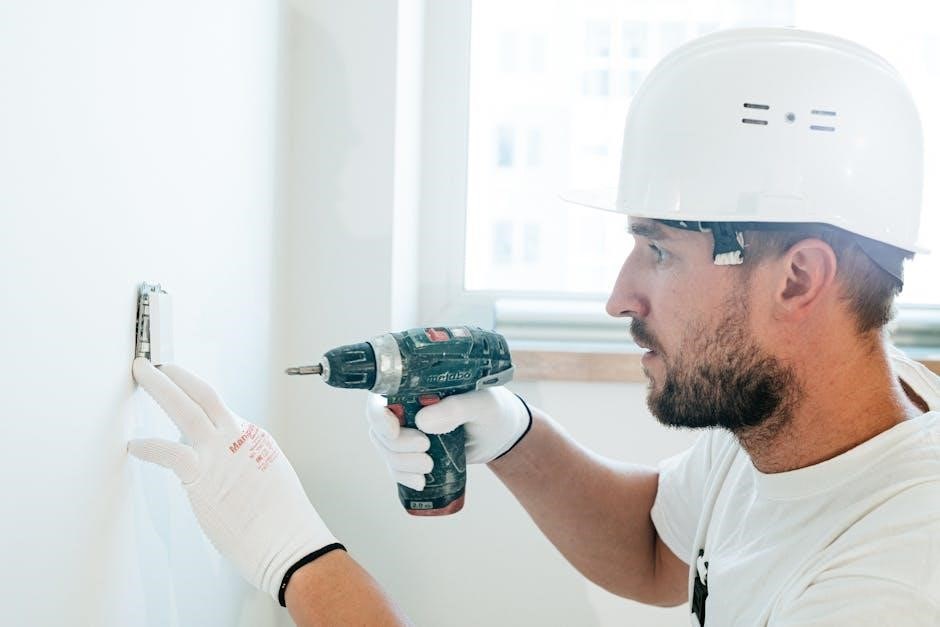gm9s96 installation manual
Welcome to the GM9S96 Installation Manual․ This guide provides comprehensive instructions for installing, configuring, and maintaining your device․ Follow the steps carefully to ensure safety and optimal performance․ Read thoroughly before starting․
1․1 Overview of the GM9S96 Device
The GM9S96 is a cutting-edge device designed for efficiency and reliability․ It features advanced technology for optimal performance, ensuring seamless operation in various environments․ With a user-friendly interface and robust construction, it is built to meet modern demands․ The device includes innovative components that enhance functionality, making it a versatile solution for diverse applications․ Its compact design allows for easy integration into existing systems, while its energy-efficient capabilities minimize resource consumption․ The GM9S96 is equipped with advanced safety features, ensuring secure and stable operation․ It supports multiple configurations, catering to different user needs․ Regular updates and maintenance ensure long-term reliability․ This device is a reliable choice for professionals and enthusiasts alike, offering a balance of power and precision․ Proper installation and configuration are essential to unlock its full potential․ Understanding its capabilities and limitations will help users maximize its performance․ Always refer to the manual for specific guidelines and recommendations․
1․2 Importance of Proper Installation
Proper installation of the GM9S96 device is crucial for ensuring optimal performance, safety, and longevity․ Incorrect installation can lead to malfunctions, reduced efficiency, or even safety hazards․ By following the guidelines outlined in this manual, users can avoid common pitfalls and ensure the device operates as intended․ Proper installation also guarantees compliance with safety standards, minimizing risks to both the user and the device․ Additionally, correct setup ensures that all features and functionalities are fully accessible, enabling users to maximize the device’s capabilities․ Improper installation may void warranties or lead to premature wear and tear, resulting in additional costs and downtime․ Therefore, it is essential to adhere strictly to the installation procedures provided in this manual․ This ensures a safe, efficient, and reliable operation of the GM9S96 device, meeting both user expectations and manufacturer specifications․ Always double-check each step to confirm accuracy and completeness before proceeding․

System Requirements for GM9S96
The GM9S96 requires a compatible operating system, sufficient processor speed, and adequate memory․ Ensure your system meets these specifications for optimal performance․ Refer to the manual for detailed hardware and software compatibility․
2․1 Hardware Requirements
The GM9S96 requires specific hardware to operate efficiently․ Ensure your system has a compatible processor with a minimum speed of 2․0 GHz, at least 4 GB of RAM, and a storage capacity of 500 GB or more․ A dedicated graphics card is recommended for enhanced performance․ Additionally, the device must be connected to a power supply that meets the voltage and current specifications outlined in the manual․ Verify that your system’s motherboard supports the necessary interfaces for the GM9S96, such as USB 3․0 ports and an HDMI connection․ Proper cooling systems are essential to prevent overheating during operation․ If your hardware does not meet these requirements, performance may be affected․ Always check the compatibility of your hardware before proceeding with the installation to ensure smooth operation and avoid potential issues․ Refer to the manual for detailed specifications and recommendations․
2․2 Software Compatibility
Ensure your system runs compatible software for the GM9S96․ The device supports Windows 10/11, macOS Monterey or later, and Linux distributions like Ubuntu 20․04․ Install the latest drivers from the official website to ensure proper functionality․ Firmware updates are crucial for optimal performance and security․ Compatibility with third-party software tools may vary, so verify requirements before installation․ The GM9S96 integrates seamlessly with most modern operating systems, but outdated software may cause issues․ Always check the manufacturer’s website for the latest software versions and updates․ Ensure your system meets the minimum software requirements to avoid conflicts or performance degradation․ Proper software configuration is essential for maximizing the device’s capabilities․ Refer to the manual for detailed software installation and configuration guidelines․ By adhering to these recommendations, you can ensure a smooth and efficient setup process․

Pre-Installation Preparation
Before installing the GM9S96, ensure all prerequisites are met․ Verify system compatibility, prepare necessary tools, and create a stable workspace․ Review the manual thoroughly to avoid installation delays or errors․
3․1 Unpacking and Inventory Check
Begin by carefully unpacking the GM9S96 device and all accompanying accessories from the shipping box․ Place the components on a clean, flat surface to avoid damage or misplacement․ Inspect each item for visible damage or defects․ Check the packaging list provided in the manual to ensure all components are included․ Verify the presence of the device, mounting hardware, power cables, and any additional accessories specified in your order․ Organize the parts to prevent confusion during installation․ If any items are missing or damaged, contact the supplier immediately to resolve the issue․ This step ensures a smooth installation process and helps identify potential issues early․ Always refer to the manual for a detailed description of each component and its purpose․ Proper inventory management is critical to avoiding delays or complications during the setup phase․
3․2 Site Preparation Guidelines
Before installing the GM9S96 device, ensure the installation site is properly prepared․ Clear the area of any debris, dust, or obstructions to ensure a clean working environment․ Verify that the surface where the device will be mounted is level and stable to prevent uneven installation․ Check the power supply to ensure it meets the device’s voltage and current requirements, as specified in the manual․ Ensure that all necessary electrical outlets are within a reasonable distance to avoid excessive cable runs․ Proper ventilation is essential to prevent overheating, so maintain a minimum clearance of 10 cm around the device for airflow․ Additionally, ensure that the site is accessible and free from hazards to guarantee safe and efficient installation․ Finally, confirm that all required tools and documentation are readily available to streamline the process․ Proper site preparation is crucial for a successful and trouble-free installation․ Always adhere to the manufacturer’s guidelines to ensure optimal performance․

Installation Process
The installation process involves mounting the device securely, connecting electrical components precisely, and configuring the system for optimal performance․ Follow the manual step-by-step to ensure a smooth and successful setup․
4․1 Mounting the Device
Mounting the GM9S96 device requires careful planning and precision to ensure stability and proper alignment․ Begin by selecting a suitable location that meets the specified environmental conditions․ Use the provided mounting bracket to secure the device firmly to the surface․ Ensure the device is level and aligned correctly to prevent any operational issues․ Tighten the screws gradually, following the torque specifications provided in the manual․ Avoid over-tightening, as this may damage the mounting bracket or the device itself․ Double-check the alignment and stability before proceeding to the next installation steps․ If mounting on a wall, ensure the surface can support the weight of the device․ For floor mounting, verify the surface is even and free from obstructions․ Always refer to the manual for specific mounting hardware recommendations and torque values to ensure a secure installation․
4․2 Connecting Electrical Components
Connecting the electrical components of the GM9S96 device is a critical step that requires attention to detail to ensure safe and proper functionality․ Begin by ensuring the device is powered off before making any connections․ Locate the designated electrical ports and carefully connect the power supply unit, ensuring it is compatible with the device’s voltage and current requirements․ Use the provided cables or those specified in the manual to connect sensors, actuators, and other peripheral devices․ Follow the wiring diagram provided in the manual to avoid any mismatches or short circuits․ Secure all connectors firmly to prevent loose connections, which could lead to malfunctions․ After connecting all components, double-check the wiring for accuracy and integrity․ Power on the device and verify that all electrical connections are functioning as expected․ If unsure about any step, consult the manual or seek assistance from a qualified technician to ensure safety and proper installation․
4․3 Initial Setup and Configuration
After completing the physical installation, proceed to the initial setup and configuration of the GM9S96 device․ Begin by powering on the device and verifying that all status indicators light up as expected․ Use the touchscreen or control panel to access the main menu, then navigate to the setup section․ Enter the administrator credentials provided in the manual or set up new ones for secure access․ Configure basic settings such as date, time, and communication protocols․ If required, load the default configuration profile or customize settings based on your specific requirements․ Run a self-test to ensure all systems are operational․ Review the configuration to confirm accuracy and save the settings to prevent data loss․ If issues arise during setup, refer to the troubleshooting section or contact technical support․ Proper configuration is essential for optimal performance, so double-check all parameters before proceeding to the next steps․

Configuration and Customization
Configure the GM9S96 to meet specific requirements by adjusting parameters and enabling advanced features․ Customize settings for optimal performance, ensuring compatibility with existing systems․ Utilize the intuitive interface to tailor functionality to your needs․
- Adjust device parameters for enhanced efficiency․
- Enable or disable features based on operational demands․
- Optimize settings for improved system integration and adaptability․
5․1 Setting Up Device Parameters
Setting up device parameters is crucial for ensuring the GM9S96 operates according to your specific requirements․ Begin by accessing the device’s control panel or software interface, where you can configure key settings such as operation mode, data acquisition rates, and communication protocols․
Navigate through the menu to adjust parameters like baud rate, parity, and data bits for serial communication․ Additionally, set thresholds for alarms, logging intervals, and system responses․ Ensure all configurations align with your application’s needs for optimal performance․
Save your settings and restart the device to apply changes․ Refer to the manual for default values and guidelines to avoid incorrect configurations․ Proper parameter setup ensures reliability, efficiency, and seamless integration with other systems․
For advanced users, custom profiles can be created and stored for quick deployment in similar setups․ Always verify parameter settings before finalizing to prevent operational issues․
Consult the parameter reference table in the appendix for detailed descriptions and valid ranges․
5․2 Customizing Features for Optimal Performance
Customizing the GM9S96’s features ensures the device meets your specific operational needs․ Start by accessing the advanced settings menu, where you can tailor functionalities such as data filtering, display options, and alarm notifications․
Adjust the device’s output signals, communication protocols, and data logging intervals to suit your application․ Enable or disable optional features like remote monitoring or data encryption based on your requirements․
Use the customization tools to define custom alerts and notifications, ensuring timely responses to critical events․ For enhanced performance, calibrate sensors and adjust sensitivity levels to match environmental conditions․
Experiment with different configurations to optimize accuracy and responsiveness․ Save custom profiles for quick deployment in similar setups․ Always test configurations thoroughly to ensure they meet your operational goals․
Refer to the manual for guidance on advanced customization options and troubleshooting tips․ Proper customization enhances efficiency, reliability, and user satisfaction․
Remember to back up settings before making significant changes to avoid data loss․

Troubleshooting Common Issues
Troubleshooting the GM9S96 involves identifying and resolving errors efficiently․ Common issues include error messages, connectivity problems, or malfunctioning sensors․ Always refer to the manual for diagnostic guides and solutions․
- Check power supply and connections for stability․
- Review error logs for specific fault codes․
- Reset the device if necessary and reconfigure settings․
Regular updates and maintenance can prevent recurring issues․
6․1 Identifying and Diagnosing Problems
Identifying and diagnosing issues with the GM9S96 requires a systematic approach․ Start by reviewing error messages or LED indicators on the device, as they often provide specific fault codes․ Common problems include connectivity issues, sensor malfunctions, or software glitches․
- Check the error log for detailed information about the issue․
- Verify all connections to ensure they are secure and undamaged․
- Perform a visual inspection of sensors and cables for physical damage․
Consult the troubleshooting section of the manual for interpretations of error codes․ If the issue persists, restart the device or restore default settings․ Always ensure the firmware is up to date, as outdated versions can cause unexpected behavior․
6․2 Resolving Common Errors
Resolving common errors during the GM9S96 installation involves addressing both hardware and software issues․ Start by checking power supply connections, as insufficient voltage is a frequent problem․ Ensure all cables are securely connected to the correct ports to avoid communication errors․
- If the device fails to power on, verify the power source and check for blown fuses․
- For software-related issues, reinstall or update the firmware using the provided utility tool․
- Reset the device to factory settings if configuration errors persist․
Consult the error code reference in the manual for specific solutions․ Regularly updating drivers and ensuring compatibility with connected systems can prevent recurring issues․ If problems remain unresolved, contact technical support for further assistance․

Maintenance and Upkeep
- Regularly clean the device to prevent dust buildup․
- Check for firmware updates to ensure optimal performance․
- Inspect connections and cables for wear or damage․
- Schedule periodic diagnostic tests to identify potential issues early․
7․1 Routine Maintenance Tasks
Regular maintenance is essential to ensure the GM9S96 device operates efficiently and maintains its longevity․ Begin by cleaning the exterior and internal components to remove dust or debris, which can interfere with performance․ Use compressed air or a soft brush for this purpose․ Next, inspect all electrical connections and cables for signs of wear or damage, replacing them if necessary․ Check the firmware version and update it if a newer version is available, as updates often improve functionality and security․ Additionally, verify the cooling system to ensure proper airflow, as overheating can lead to malfunctions․ Finally, review the power supply to confirm it meets the device’s requirements and is free from fluctuations․ By adhering to these routine tasks, you can prevent potential issues and ensure the device runs smoothly over time․
7․2 Best Practices for Longevity
To maximize the lifespan of the GM9S96 device, adopt a few best practices․ Ensure the device operates in an environment with stable power supply and controlled temperature and humidity levels․ Avoid exposing the device to extreme conditions, as this can degrade its components over time․ Use high-quality cables and connectors to minimize signal loss and interference․ Regularly back up important data to prevent losses in case of unexpected failures․ When handling the device, use anti-static equipment to protect sensitive electronic components from damage․ Additionally, shield the device from direct sunlight and moisture, as these can cause overheating and corrosion․ Finally, always follow the manufacturer’s guidelines for updates, repairs, and replacements to ensure optimal performance and longevity․ By implementing these practices, you can significantly extend the operational life of the GM9S96 and maintain its reliability․

Safety Precautions

Ensure safety by disconnecting power before installation․ Use insulated tools to prevent electrical shocks․ Wear safety glasses and anti-static wrist straps․ Properly ground the system to avoid static damage․
8․1 General Safety Guidelines
Always prioritize safety when handling the GM9S96 device to prevent injuries and ensure proper installation․ Begin by wearing appropriate personal protective equipment (PPE), such as safety glasses and insulated gloves, to protect against electrical hazards․ Ensure the work area is well-ventilated and free from flammable materials․ Before starting any installation tasks, disconnect all power sources to avoid electrical shocks or injuries․ Use non-conductive tools to prevent unintended short circuits․ Properly ground yourself using an anti-static wrist strap to avoid damaging sensitive components․ Never attempt to install or repair the device near open flames or sparks․ Keep loose clothing and long hair tied back to avoid entanglement with moving parts․ Familiarize yourself with emergency procedures, such as knowing the location of fire extinguishers and first aid kits․ Always follow local safety regulations and manufacturer recommendations to ensure a safe working environment․ These precautions are essential to safeguard both the installer and the device․
8․2 Handling Electrical Components Safely
When handling electrical components of the GM9S96, ensure all power sources are disconnected to prevent shocks or electrical hazards․ Use insulated tools to avoid direct contact with live circuits, and verify voltage levels before proceeding․ Avoid overloading circuits, as this can lead to system malfunctions or fire risks․ Always ground electrical components properly to prevent damage from static electricity․ Never touch electrical parts with wet hands or while standing on conductive surfaces․ If a component appears damaged or worn, disconnect power immediately and replace it with an approved substitute․ Keep children and unauthorized personnel away from electrical components to minimize accident risks․ Regularly inspect cables and connectors for signs of wear or fraying, and replace them if necessary․ Follow the manufacturer’s guidelines for handling sensitive electronic parts to maintain system integrity and ensure safe operation․ Proper handling of electrical components is critical for both personal safety and the longevity of the GM9S96 device․
Successful installation of the GM9S96 ensures optimal performance and reliability․ By following this manual, users can confidently complete the setup and maintain the device for future operations․
9․1 Summary of Key Installation Steps
To ensure a smooth and successful installation of the GM9S96, follow these key steps: begin with proper unpacking and inventory of all components․ Next, prepare the installation site according to the specified guidelines to avoid any obstructions or hazards․ Mount the device securely, ensuring it is level and firmly fastened to prevent movement during operation․ Connect all electrical components correctly, double-checking wiring and power sources to meet the device’s requirements․ Complete the initial setup by configuring basic parameters and performing a system test to verify functionality․ Always refer to the manual for specific instructions and safety precautions․ By adhering to these steps, you can ensure the GM9S96 operates efficiently and reliably, minimizing the risk of errors or malfunctions․

9․2 Final Checks and Verification
After completing the installation, perform a thorough verification to ensure the GM9S96 operates as intended; Begin by visually inspecting all connections to confirm they are secure and properly aligned․ Power on the device and check for any error indicators or unusual behavior․ Run the built-in diagnostic tests to verify system functionality and performance․ Review the configuration settings to ensure they match the intended parameters․ Test all features and interfaces to confirm they respond correctly․ Finally, review the installation site to ensure compliance with safety guidelines and proper environmental conditions․ Document the final setup for future reference and maintenance․ This step ensures the system is ready for operational use and minimizes the risk of post-installation issues․ Proper verification is essential for optimal performance and longevity of the GM9S96 device․
